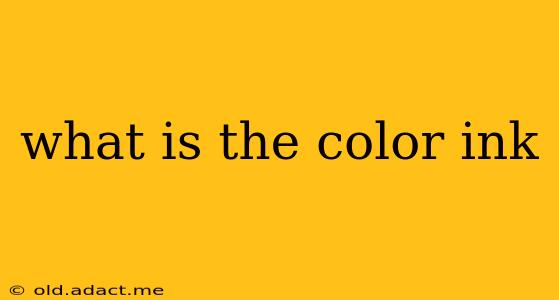What is Color Ink? A Deep Dive into the World of Printing
Color ink, in its simplest form, is a liquid or paste-like substance used to create images and text on various surfaces. But the world of color ink is far more complex than that simple definition suggests. This comprehensive guide will explore the different types, compositions, and applications of color ink, answering many frequently asked questions along the way.
What are the different types of color inks?
Color inks are categorized in various ways, primarily by their chemical composition and intended use. The most common categories include:
-
Dye-based inks: These inks use water-soluble dyes as the coloring agent. They are generally less expensive and produce vibrant, but less lightfast colors. They're frequently found in inkjet printers designed for home use, as they're easier on the print heads and produce sharp results on standard paper. However, they are prone to fading over time.
-
Pigment-based inks: These inks use insoluble pigments suspended in a liquid. Pigment-based inks are more durable, lightfast, and water-resistant than dye-based inks, making them ideal for documents that need to last. You'll commonly find these in professional printers and those designed for photo printing, where longevity is crucial. They tend to be more expensive and may require special paper types for optimal results.
-
Solvent-based inks: Used for printing on a wider range of materials, including plastics, metals, and fabrics, these inks utilize solvents to dissolve the pigments and allow them to penetrate the surface effectively. Their high durability and resistance to fading make them the choice for outdoor signage, packaging, and other applications requiring high resistance to wear and weather.
-
UV-curable inks: These inks utilize ultraviolet light to cure or harden the ink, creating a highly durable and scratch-resistant finish. Commonly used in wide-format printing and other specialized applications, they are known for their vibrant colors and fast drying times.
What is the difference between dye and pigment ink?
The core difference lies in the coloring agent. Dye-based inks use dyes that dissolve into the paper, resulting in bright, vivid colors that can be somewhat transparent. Pigment-based inks, on the other hand, use tiny pigment particles that sit on top of the paper, leading to more durable, less vibrant, and opaque results. The choice between dye and pigment depends entirely on the application and desired longevity.
What is the chemistry behind color inks?
The chemistry of color inks is intricate and varies greatly depending on the type of ink. Generally, they comprise a colorant (dye or pigment), a solvent (water, alcohol, or other chemicals) to disperse the colorant, and potentially other additives like resins, surfactants, and UV absorbers to enhance performance. The specific chemical makeup influences factors like viscosity, drying time, and lightfastness.
How are different colors of ink made?
Different colors are created by carefully mixing various pigments or dyes. CMYK (Cyan, Magenta, Yellow, and Black) is the standard color model used in printing. By varying the proportions of these four base colors, a wide spectrum of hues can be achieved. However, it's important to note that the resulting colors are often approximations of the desired shades, particularly with dye-based inks.
What are the environmental impacts of color inks?
The environmental impact of ink production and disposal is a significant concern. Some inks contain volatile organic compounds (VOCs) that can contribute to air pollution. The disposal of ink cartridges also presents a waste management challenge. Fortunately, many manufacturers are developing more eco-friendly inks with reduced VOC content and recyclable cartridges, promoting sustainable printing practices.
This exploration of color ink hopefully clarifies the various aspects of this essential printing component. The selection of the appropriate ink type depends heavily on the intended application, desired longevity, and the available budget. By understanding these distinctions, one can make an informed decision for any printing project, regardless of size or scope.
